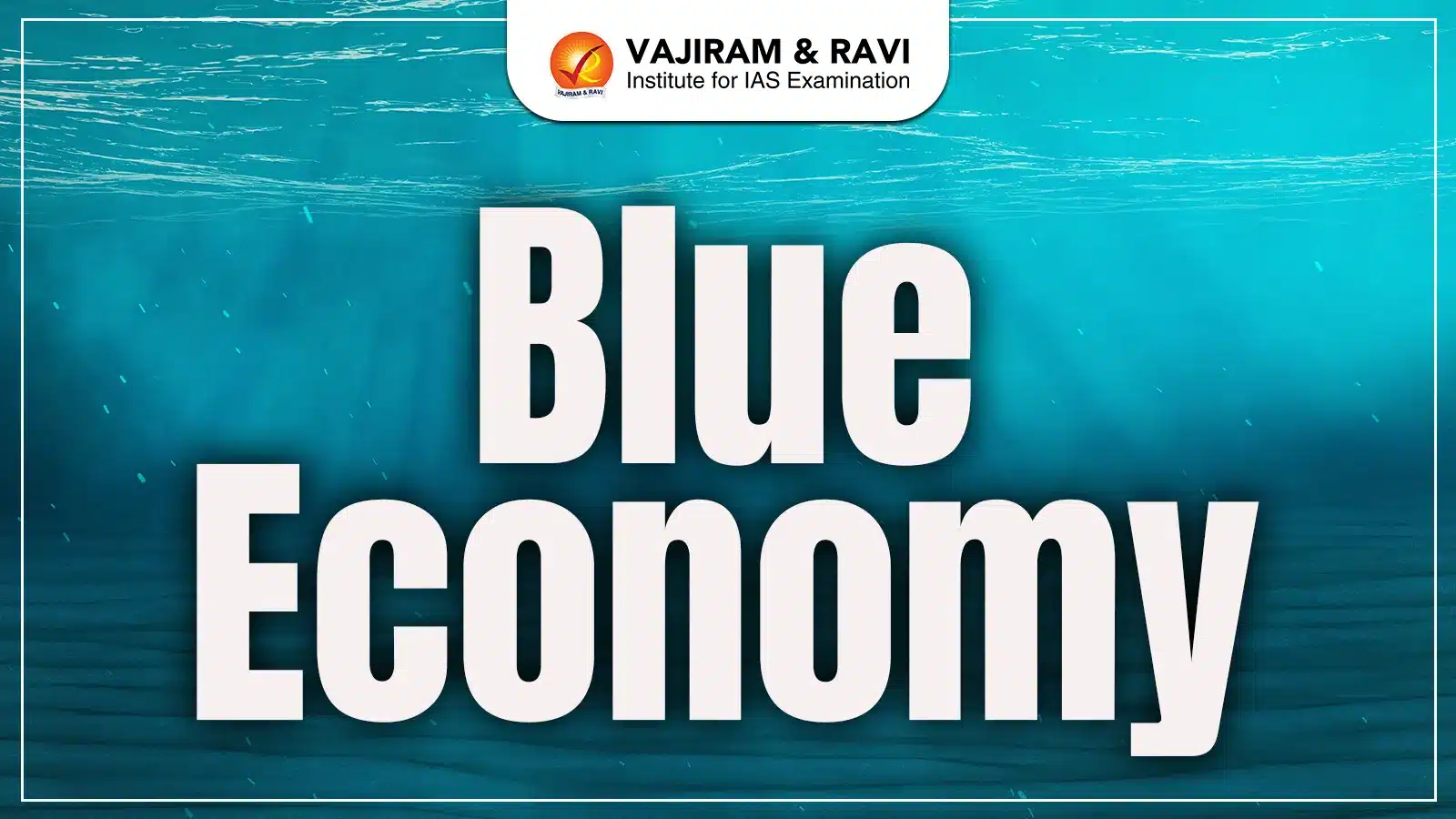Blue Economy focuses on the sustainable use of ocean resources to drive economic growth, improve livelihoods, and protect marine ecosystems. It promotes sectors like fishing, tourism, and renewable energy while addressing climate change and marine pollution. The Interim Budget 2024 introduced Blue Economy 2.0, emphasising coastal ecosystem restoration, sustainable aquaculture, and a multi-sectoral approach.
With oceans covering 75% of Earth's surface and contributing significantly to global GDP, the Blue Economy is vital for sustainable development. Key initiatives include the Sagarmala Project, Deep Ocean Mission, and international collaborations like the India-Norway Task Force.
Blue Economy Meaning
The Blue Economy is a new concept that promotes the sustainable use of ocean resources for economic growth, improved livelihoods, and job creation while protecting the health of ocean ecosystems. It balances economic development with environmental sustainability, addressing challenges like climate change, pollution, and overfishing to ensure long-term marine resilience.
- The World Bank defines the blue economy as the "sustainable use of ocean resources for economic growth, improved livelihoods, and jobs while preserving the health of the ocean ecosystem."
- The European Commission defines it as "all economic activities relating to oceans, seas, and coasts." It encompasses a large number of interconnected established and emerging sectors."
Blue Economy Objectives
The objective of the Blue Economy is to foster economic development while ensuring the protection of ocean and coastal ecosystems. It emphasises the sustainable use of marine resources to boost employment, improve food availability, and promote innovation in areas like fisheries, tourism, and ocean-based renewable energy.
- Additionally, it seeks to minimise marine pollution, preserve biodiversity, and support climate-adaptive coastal infrastructure.
- The approach aims to achieve inclusive growth for communities dependent on the sea while maintaining the long-term health and productivity of marine environments.
Blue Economy 2.0
Blue Economy 2.0 is an integrated initiative focused on climate-resilient development, restoration of coastal ecosystems like mangroves, and sustainable expansion of aquaculture and mariculture in India’s coastal regions.
- The Interim Budget 2024 highlights Blue Economy 2.0, introducing a scheme focused on coastal restoration, adaptation, and sustainable aquaculture.
- It aims to promote climate resilience and sustainable development in coastal areas, addressing threats from climate change, pollution, and overexploitation to protect ocean resources.
- The initiative highlights India's focus on enhancing its maritime economy, crucial for its 7,500 km coastline and 2.2 million sq km Exclusive Economic Zone (EEZ)
- Blue Economy 2.0 aligns with national goals like "Vision 2025" and the "Deep Ocean Mission" launched in 2021 to boost maritime infrastructure.
Blue Economy 2.0 Key Components
Key components of Blue Economy 2.0 include the restoration of coastal ecosystems, the promotion of sustainable aquaculture, and a multi-sectoral approach integrating Blue Economy goals into policies with technology and collaboration.
- Coastal Ecosystem Restoration: Focuses on restoring mangroves and coral reefs using natural and artificial interventions, including shoreline protection, beach nourishment, and climate-proofing to address sea-level rise and extreme weather.
- Expansion of Coastal and Mariculture: Promotes sustainable aquaculture and mariculture, supporting high-value marine species and seaweed farming, with government funding, tax incentives, and subsidies to encourage eco-friendly practices.
- Integrated Multi-Sectoral Approach: A coordinated strategy across sectors like shipping, ports, tourism, energy, and biotechnology, integrating the blue economy into national and state policies with tech-driven planning and stakeholder collaboration.
Need for Blue Economy
Need for Blue Economy arises from the urgent need to sustainably harness vast oceanic resources for economic growth, livelihood security, climate change mitigation, and marine biodiversity conservation, while addressing challenges like pollution and overexploitation.
- Vast Marine Resources: Oceans cover 75% of Earth, hold 97% of its water, and provide 99% of its living space. They host diverse biodiversity essential for ecological balance, human consumption, and sustainable development.
- Global GDP Contribution: Oceans generate 3-5% of global GDP, valued at USD 1.5 trillion annually, ranking as the seventh-largest economy. This is expected to double to USD 3 trillion by 2030, highlighting its growing economic importance.
- Human Dependency: 40% of the global population resides in coastal areas, over 3 billion rely on oceans for livelihoods, and 80% of global trade operates via maritime routes, emphasising its critical role.
- Climate Change Mitigation: Oceans act as carbon sinks, absorbing 30% of global CO2 emissions. Sustainable practices can further enhance their role in mitigating climate change and preserving ecosystems.
- Renewable Energy: Promotes offshore wind, tidal, and wave energy as sustainable sources, boosting energy security while reducing fossil fuel reliance and carbon emissions.
- Marine Pollution: Addresses threats like plastic waste (75-199 million tons), chemical runoff, and sewage, with 33 billion pounds of plastic entering oceans annually, aiming to protect marine life and ecosystems.
Blue Economy in India
Blue Economy in India focuses on the sustainable use of ocean resources for economic growth, improved livelihoods, and jobs while preserving marine health. Currently, it contributes about 4% to India’s Gross Domestic Product (GDP), with sectors like fisheries, aquaculture, shipping, tourism, and offshore energy playing key roles.
- India boasts a coastline of over 7,500 kilometres and an Exclusive Economic Zone of about 2.02 million square kilometres, handling 95% of its trade by volume through maritime routes.
- The fisheries sector alone supports around 3.5 million people directly and up to 30 million indirectly, making India the third-largest fish producer globally.
- Despite this, the sector remains underutilised, with significant potential for growth in marine biotechnology, renewable ocean energy, and eco-tourism.
- Government initiatives like the Draft Blue Economy Policy, Sagarmala, and Deep Ocean Mission aim to unlock this potential, targeting a blue economy contribution of up to $1 trillion by 2030.
Blue Economy Importance
The Blue Economy is an important framework for achieving sustainable development by leveraging the vast resources of the world's oceans. It plays a significant role in the economic, environmental, and social dimensions of global and national development.
- Economic Growth and Job Creation: The blue economy drives global growth through industries like fishing, tourism, marine biotech, and shipping, supporting millions of livelihoods, especially in coastal and island nations.
- High Return on Investment: According to research commissioned by the high-level panel for a sustainable ocean economy, USD1 invested in key ocean activities yields five times the return, or USD5, and often more.
- Climate Change Mitigation: Oceans absorb CO2, helping regulate the climate. The blue economy emphasises conserving marine ecosystems like mangroves, coral reefs, and seagrasses, which act as carbon sinks, mitigating climate change while preserving biodiversity.
- Sustainable Development Goals: The blue economy is critical to achieving several SDGs, particularly SDG 14 "Life Below Water", which focuses on the conservation and sustainable use of the oceans, seas, and marine resources.
Blue Economy Initiatives
Blue economy initiatives aim to promote the sustainable use and conservation of ocean resources while driving economic growth. These initiatives span both global and national levels, addressing various aspects of marine and coastal management.
- Global Ocean Alliance: A coalition of governments and organisations working to protect 30% of the world’s oceans by 2030. The alliance promotes the establishment of Marine protected areas (MPAs) and the implementation of sustainable fisheries management.
- The Ocean Decade: The United Nations Decade of Ocean Science for Sustainable Development (2021-2030) aims to improve ocean science and foster the sustainable management of ocean resources.
- Sagarmala Project: The Sagarmala Project aims to modernise, mechanise, and computerise the port infrastructure along the 7,516-kilometer-long coastline. The projects under this project aim to develop coastal infrastructure, coastal industries, coastal communities, and coastal tourism.
- Deep Ocean Mission: India's ambitious Deep Ocean Mission aims to explore and harness the ocean's depths. The mission seeks to address scientific and economic issues related to ocean exploration and resource utilisation.
- O-SMART: The O-SMART scheme consists of 16 sub-projects addressing ocean development activities, including Services, Technology, Resources, Observations, and Science.
- India-Norway Task Force on Blue Economy for Sustainable Development: It was established jointly in 2020 to develop and implement joint initiatives between the two countries.
- National Policy on Marine Fisheries (2017): It aims to ensure the sustainable development of marine fisheries, improve livelihoods, and enhance fish production. Key actions include implementing sustainable fishing practices, expanding Marine Protected Areas (MPAs), and supporting the blue economy through research and technology.
Blue Economy Challenges
The development of the blue economy, while promising, faces several significant challenges that need to be addressed to ensure its sustainability and effectiveness.
- Overfishing: Overfishing poses a significant threat to marine biodiversity and the long-term viability of fish stocks. The Food and Agriculture Organisation (FAO) estimates that 34% of global fish stocks are overfished, resulting in the extinction of important species and the disruption of marine ecosystems.
- Marine Pollution: Pollution, particularly plastic waste, has a severe impact on the oceans, endangering marine life and ecosystems. According to the United Nations, approximately 8 million tonnes of plastic annually enter the ocean.
- Climate Change: Climate change is raising ocean temperatures, resulting in coral bleaching, shifting marine species distributions, and weakening ocean currents. Ocean acidification, caused by increased CO2 absorption, endangers shellfish and coral reefs.
- Weak Governance and Enforcement: Many countries need more institutional capacity to effectively enforce marine regulations, resulting in the exploitation of marine resources and the degradation of ecosystems.
Blue Economy Way Forward
The future of the blue economy holds great potential, but realising this potential requires strategic action, collaboration, and innovation. Further needed steps include the following:
- International Cooperation: Foster stronger international partnerships and collaboration among countries, particularly those with shared maritime borders, through regional bodies like the Indian Ocean Rim Association (IORA).
- Sustainable Aquaculture: Scale up sustainable fishing practices and responsible aquaculture, focusing on ecosystem-based management.
- Infrastructure Investment: Investing in coastal infrastructure, such as ports, airports, and other facilities, can help to support economic growth and expansion.
- Developing Blue Finance Mechanisms: Create and expand financial instruments that support sustainable blue economy initiatives, such as blue bonds, climate finance, and public-private partnerships.
- Enhancing Marine Spatial Planning (MSP): Implement comprehensive Marine Spatial Planning to harmonise the use of ocean spaces for various activities, such as fishing, tourism, and shipping.
Blue Economy UPSC PYQs
Question 1: Defining the blue revolution, explain the problems and strategies for pisciculture development in India. (UPSC Mains 2018)
Question 2: What is blue carbon? (UPSC Prelims 2021)
(a) Carbon captured by oceans and coastal ecosystems
(b) Carbon sequestered in forest biomass and agricultural soils
(c) Carbon contained in petroleum and natural gas
(d) Carbon present in the atmosphere
Ans: (a)
Last updated on December, 2025
→ Check out the latest UPSC Syllabus 2026 here.
→ Join Vajiram & Ravi’s Interview Guidance Programme for expert help to crack your final UPSC stage.
→ UPSC Mains Result 2025 is now out.
→ UPSC Notification 2026 is scheduled to be released on January 14, 2026.
→ UPSC Calendar 2026 is released on 15th May, 2025.
→ The UPSC Vacancy 2025 were released 1129, out of which 979 were for UPSC CSE and remaining 150 are for UPSC IFoS.
→ UPSC Prelims 2026 will be conducted on 24th May, 2026 & UPSC Mains 2026 will be conducted on 21st August 2026.
→ The UPSC Selection Process is of 3 stages-Prelims, Mains and Interview.
→ UPSC Result 2024 is released with latest UPSC Marksheet 2024. Check Now!
→ UPSC Prelims Result 2025 is out now for the CSE held on 25 May 2025.
→ UPSC Toppers List 2024 is released now. Shakti Dubey is UPSC AIR 1 2024 Topper.
→ UPSC Prelims Question Paper 2025 and Unofficial Prelims Answer Key 2025 are available now.
→ UPSC Mains Question Paper 2025 is out for Essay, GS 1, 2, 3 & GS 4.
→ UPSC Mains Indian Language Question Paper 2025 is now out.
→ UPSC Mains Optional Question Paper 2025 is now out.
→ Also check Best IAS Coaching in Delhi
Blue Economy FAQs
Q1. What is the Blue Economy concept?+
Q2. What is India's blue economy?+
Q3. Who introduced blue economy?+
Q4. What is red economy?+
Q5. What are the aims of blue economy?+

















